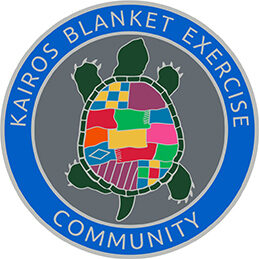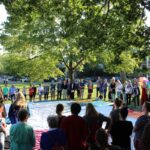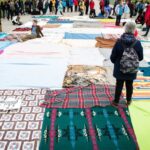Tansi Nîtôtemtik,
In light of the TRC Calls to Action, in particular number 28, which calls upon law schools in Canada to inform their students of the history and legacy of the residential school system1, all incoming 1Ls to the faculty participated in the KAIROS Blanket Exercise last Tuesday. The exercise was facilitated by Jodi Stonehouse, radio host of Acimowin, Koren Lightening-Earle, Faculty of Law Alumna, and Professor Hadley Friedland.
So, what is the KAIROS Blanket Exercise? The exercise is an interactive learning experience that covers over 500 years of history in roughly two hours. The participants of the exercise, this year’s 1Ls, took on the role of the Indigenous peoples of Canada, while the facilitators acted as colonizers. Blankets are utilized to represent Indigenous lands, and as time progresses from pre-contact to colonization, blankets are removed as Indigenous lands are occupied by the colonizers.
Processes of cultural genocide are read aloud by the participants. Such processes depict Canada’s Aboriginal policy, which aimed to assimilate the Aboriginal peoples in an effort to terminate their existence as distinct legal, social, cultural, religious, and racial entities in Canada.2 The residential school system is one major example of cultural genocide, a system funded by Canada and operated by certain religious organizations to “educate” Aboriginal children. Although on its face these schools were a learning institute, they were created primarily to break the children’s link to their culture and identity.3 The Canadian government labelled Aboriginal parents as unfit to parent, and thus removed the children from their families and communities. Their languages and culture were suppressed, with harsh discipline for those that went against these rules.4 Between the government’s underfunding for Aboriginal policy and the church’s resolve to convert as many children as possible, these schools became sites of “hunger, overwork, danger and disease, limited education, and, in tens of thousands of cases, physical, sexual, and psychological abuse and neglect.”5
Although the residential school system is often mistaken as “something of the past,” the last school shut its doors in 1996. The effects of the system continue to be felt today by survivors, their families, and their communities. In an effort to begin to repair the harms done by the schools, the Indian Residential Schools Settlement Agreement provided compensation to those students who attended one of the 139 residential schools and residences. The federal government has estimated at least 150,000 First Nation, Métis, and Inuit students have passed through the system.6 The KAIROS Blanket Exercise is one example of reconcili-action, by educating individuals of Canada’s dark past we can begin to work together towards a future in reconciliation.
Originally published on the University of Alberta, Faculty of Law blog, on September 19, 2017.


